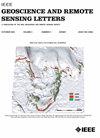低秩加稀疏分解和局部Radon变换在合成孔径雷达图像舰船尾迹检测中的应用
IF 4
3区 地球科学
Q2 ENGINEERING, ELECTRICAL & ELECTRONIC
引用次数: 51
摘要
海面杂波给尾流结构的检测和侦察带来了困难,是实现海上目标稳定运动估计的主要问题。本文介绍了一个通过评估合成孔径雷达(SAR)图像中检测到的产生的开尔文波来自动估计海上目标运动参数的完整程序。该算法是在Radon变换(RT)的辅助下,对一种双级低秩加稀疏分解(LRSD)进行杂波抑制、稀疏目标检测、精确尾迹倾斜估计和开尔文波谱分析。该算法基于凸规划实现的鲁棒主成分分析(RPCA)。LRSD算法允许从不变的低秩背景中外推由海事目标和开尔文模式组成的稀疏感兴趣目标。这种双级RPCA和RT应用于SAR监视,可以快速检测和增强海上目标的运动参数估计。本文章由计算机程序翻译,如有差异,请以英文原文为准。
Low-Rank Plus Sparse Decomposition and Localized Radon Transform for Ship-Wake Detection in Synthetic Aperture Radar Images
The problem in obtaining stable motion estimation of maritime targets is that sea clutter makes wake structure detection and reconnaissance difficult. This letter presents a complete procedure for the automatic estimation of maritime target motion parameters by evaluating the generated Kelvin waves detected in synthetic aperture radar (SAR) images. The algorithm consists in evaluating a dual-stage low-rank plus sparse decomposition (LRSD) assisted by Radon transform (RT) for clutter reduction, sparse object detection, precise wake inclination estimation, and Kelvin wave spectral analysis. The algorithm is based on the robust principal component analysis (RPCA) implemented by convex programming. The LRSD algorithm permits the extrapolation of sparse objects of interest consisting of the maritime targets and the Kelvin pattern from the unchanging low-rank background. This dual-stage RPCA and RT applied to SAR surveillance permits fast detection and enhanced motion parameter estimation of maritime targets.
求助全文
通过发布文献求助,成功后即可免费获取论文全文。
去求助
来源期刊

IEEE Geoscience and Remote Sensing Letters
工程技术-地球化学与地球物理
CiteScore
7.60
自引率
12.50%
发文量
1113
审稿时长
3.4 months
期刊介绍:
IEEE Geoscience and Remote Sensing Letters (GRSL) is a monthly publication for short papers (maximum length 5 pages) addressing new ideas and formative concepts in remote sensing as well as important new and timely results and concepts. Papers should relate to the theory, concepts and techniques of science and engineering as applied to sensing the earth, oceans, atmosphere, and space, and the processing, interpretation, and dissemination of this information. The technical content of papers must be both new and significant. Experimental data must be complete and include sufficient description of experimental apparatus, methods, and relevant experimental conditions. GRSL encourages the incorporation of "extended objects" or "multimedia" such as animations to enhance the shorter papers.
 求助内容:
求助内容: 应助结果提醒方式:
应助结果提醒方式:


